Free Shipping On Orders $100+
Stay toasty on hardwater this winter with layers and insulation.
Your cart is empty
Cart
Cart
Finesse marabou jigs have been deadly for catching smallmouth bass for as long as I have been alive. For that same amount of time, the biggest problem with marabou jigs was finding one to buy. For the longest time, these jigs were heavily guarded by the anglers who used them and crafted them. You had to “know a guy” to get even a few of these jigs for yourself.
Roughly 10 years ago, I was talked into fishing a couple bass tournaments run out of Sturgeon Bay, Wisconsin. I was familiar with Sturgeon Bay, but until these tournaments, the lion's share of my efforts in that system were focused on muskies, not smallmouth.

The Door County area is legendary for its giant brown bass and unique fishing styles. Winning on Sturgeon Bay not only requires a lot of weight, it also means you are going to have to outfish the best bass anglers in the world.
Remember, by trade, I'm a muskie guide — making an attempt to be competitive at these tournaments is a huge challenge. Finesse bass fishing in ultra-clear water is the complete opposite of how I regularly earn my paycheck. Fortunately, information about bass fishing in the area was available. In addition, there was a community of generous anglers that were willing to share quality information with me. While researching and having countless conversations — two topics always came up: finesse marabou jigs and the Canadian bass anglers that implement the tactic. I identified two problems: — I didn’t know any Canadian bass anglers, and finding a high-quality marabou bass jig to purchase was next to impossible.
For over 20 years, I have been an employee, and Thorne Brothers pro staffer. Thorne Brothers is a large tackle shop and an incredible resource for just about every genre of fishing inclusive of fly fishing.
I have a good friend who manufactures muskie lures near my home who also makes bass jigs and spinnerbaits. He helped produce my first jig heads. With the help of these resources and some internet research, I began producing my own finesse marabou jigs. I never thought fishing these events would lead me to having a hobby business of crafting and selling marabou jigs during my off season. After talking to a few anglers and accumulating a pile of internet research, I was able to get a general idea of where to start.
In essences, finesse marabou jigs are flies tied on jigs with small hooks. Very light 1/16 oz, 3/32oz and 1/8oz are the appropriate jig head weights molded on a size 1 or 1/0 hook. The overall tied size when finished is “small”. Roughly 2” to 3” in length. The objective of the jig is to hang just off the bottom as you swim it or swing it along at slow speeds. When properly tied, these jigs have an incredible amount of movement when they are barely traveling through the water.
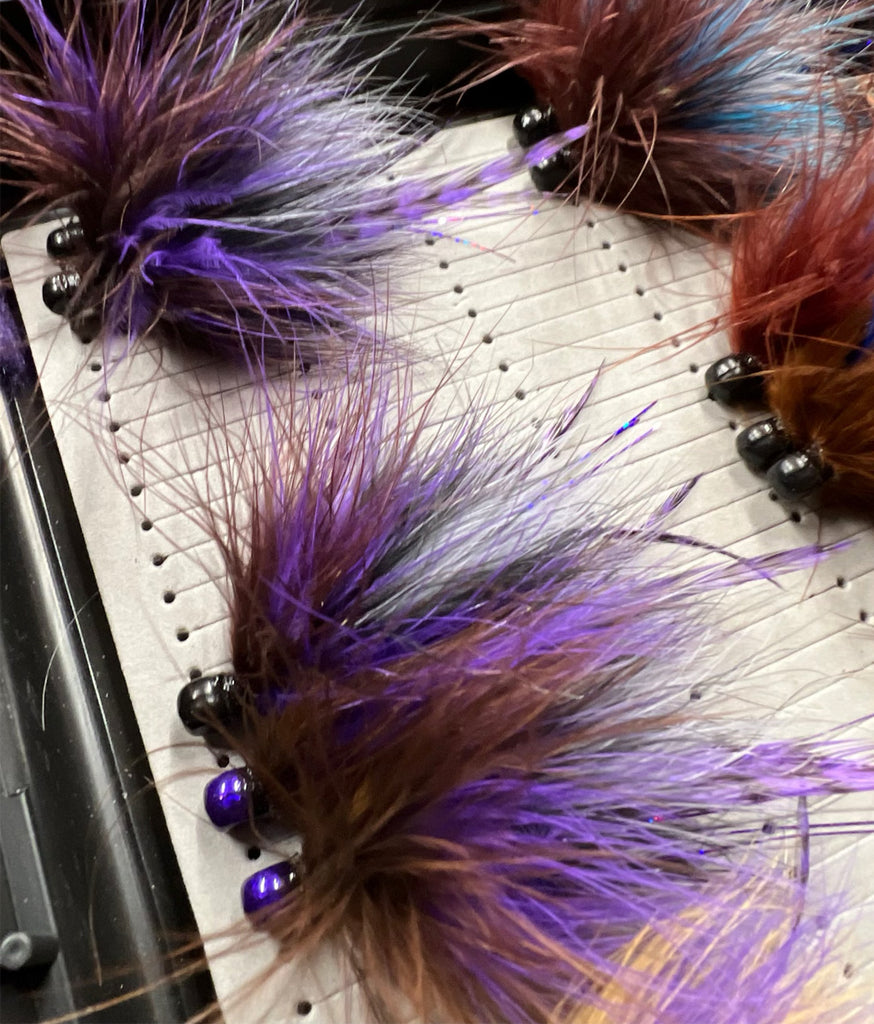
I observed a fly tying technique called palmering during an open fly tying event at Thorne Brothers. Palmering is a technique where the tyer wraps the stem of a feather around the shank of a hook. The benefit of this technique is that the quills of the feather stand straight out when wrapped. With the quills standing straight out, the jig has more action and drops slower. Both attributes are beneficial to the technique. Using this tying style uses the whole length of the quill. The average length of a quill is around 2” — a perfect length for an appropriately sized jig. Another feather that I incorporated is barred grizzly hackle. These feathers add action, contrast and a realistic profile. The feathers themselves can be mistaken for crayfish claws or appendages on a bug, both of which trigger big bass to eat. Palmering the marabou and adding the two hackle feathers makes my jigs unique while fitting the criteria of a finesse marabou jig.
Step 1: Start by tying on a wire keeper for adding a piece of soft plastic. This is also the point where I would add a few strands of flashabou (optional).

Step 2: The first feathers I add are two grizzly hackles splayed out, one on each side, cup side out. The grizzly hackles are trimmed to roughly 3”.
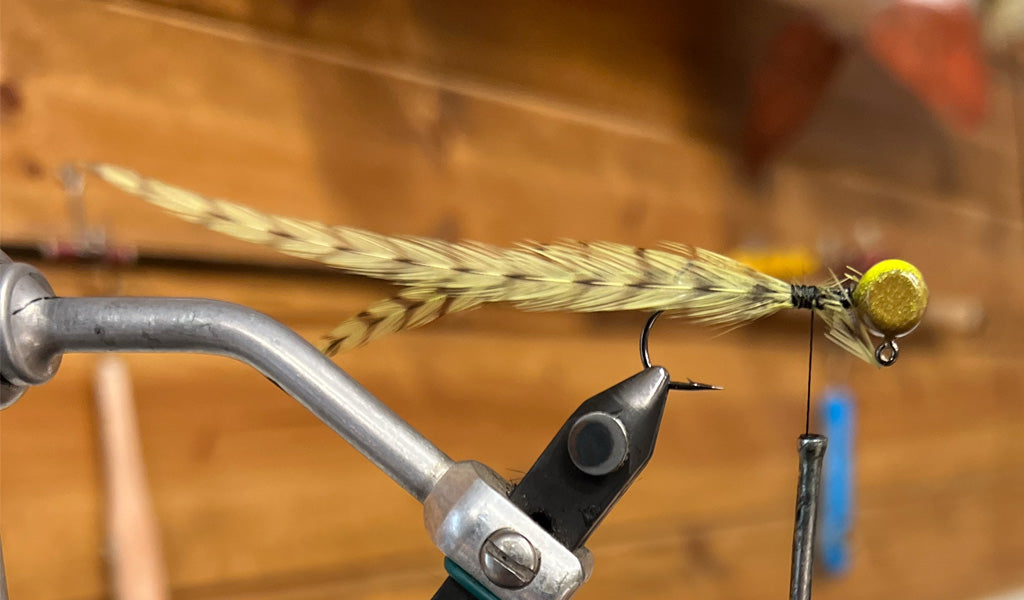
Step 3: Next, I palmer on two to four marabou feathers. There is a density that I’m looking for, not too sparse, but also, not too thick. Sometimes the desired density is achieved with two feathers and sometimes it takes four. Really, it’s dependent on the quality of feather. Ideally, the feathers you want to use are those with thinner stems and a uniform shape. You want the quills to be thinner and whisker like. Try to avoid using the bushy looking quills. If you are in a situation where the majority of the feathers you have are soft and bushy, use those as your base layer. The quills in the base layer are the least important. I also will pull the longer quills off the stem at the bottom of the feather. These are generally the poorest quality. Quality feathers truly increase the effectiveness of the jigs. You have to be willing to throw away subpar feathers even if it feels wasteful. It’s also fun to play with different quill densities used on each jig. There are times when a thinner profile will out fish a bulkier profile.
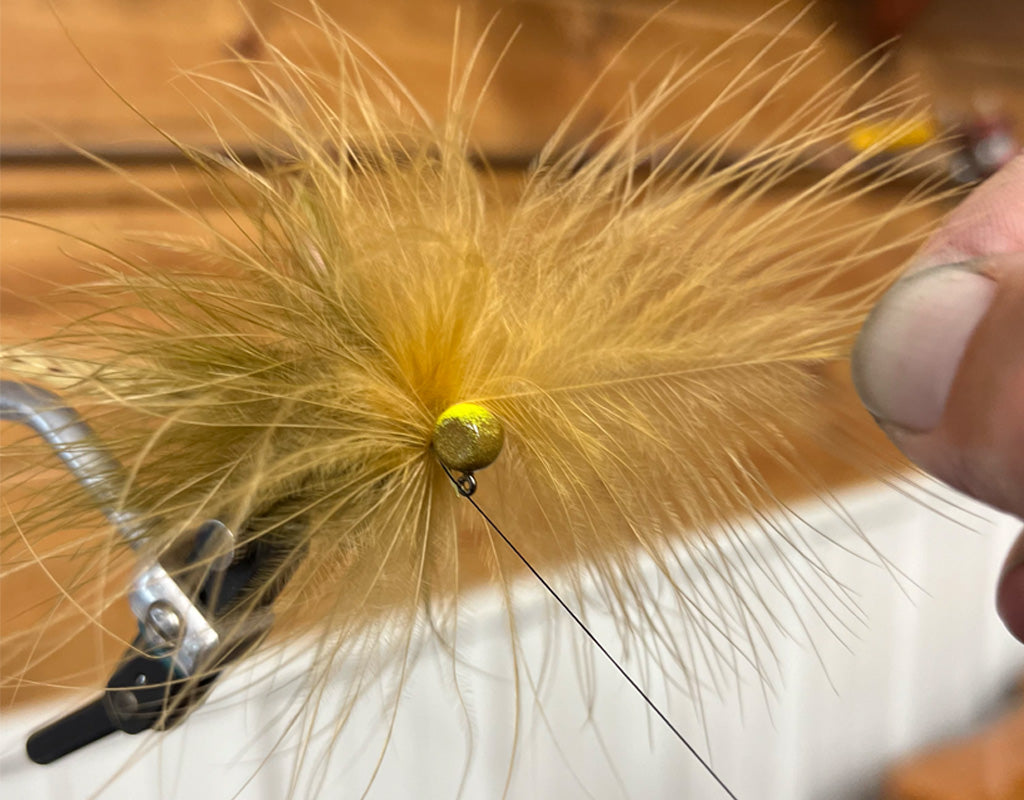
Step 3: One thing to keep in mind is how you finish the jig. For example, I try to keep the thread collar as small as possible. The marabou is where all the movement comes from. Therefore, the closer that movement starts to the jig head, the better.
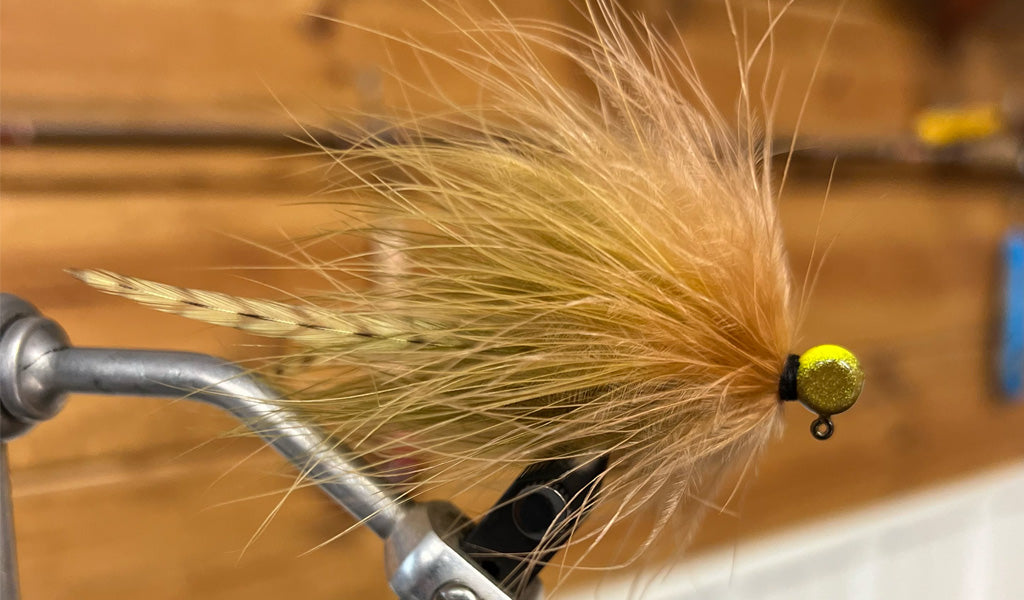
There’s definitely a lot of personal preference when choosing the jigs heads you tie on. A few production heads work well if you are planning on only making a few jigs. However, If you are planning on getting serious, you may want to look into molding your own. There are jig molds made in several styles that make 1/16th, 3/32nd and 1/8th ounce jig heads. Each jig head style will perform slightly different. Fall rates, the way the bait pendulums through the water and how it lays on the bottom are all determined by the shape of the head. I sell 2 different styles of jigs. One model is made from Do-it’s Midwest finesse mold. This is a very flat mushroom style head. The flat design of this head makes it fall much slower than other jigs of the same weight. This type of jig is also easy to feel because of the water displacement it creates. Being able to have a sense of where your jig is at in the water column is one of the most challenging parts of fishing finesse hair jigs. To me, this is the best jig head style to learn the technique with. Another benefit to this head is that it stands upright which is important if you are going to incorporate bottom contact into your retrieve.
The second jig head that I sell is made with the Do-it Freestyle mold. This is a flat sided round head. It has a faster fall rate which means it can be fished at a faster pace. The flat sides also allows water to flow right past the head onto the marabou which gives the quills even more movement. I like this style when fishing deeper water.
Color is one of my favorite aspects of tying my own jigs. The general consensus is that all black is the best color you can use. Don’t get me wrong, it is a great color, however it’s not as effective in areas where marabou jigs are popular. It excels on overcast days or on waters that see little to no marabou jig fishing pressure. Personally, one of my favorite color schemes is the combination of ginger marabou and olive marabou. This color combination does a nice job of mimicking bugs and juvenile crayfish and seems to work everywhere whether it’s overcast or sunny. A little bit of fluorescent orange in a perch pattern or brown and orange crayfish pattern works really well in our big Minnesota lakes. All white is another solid color choice.
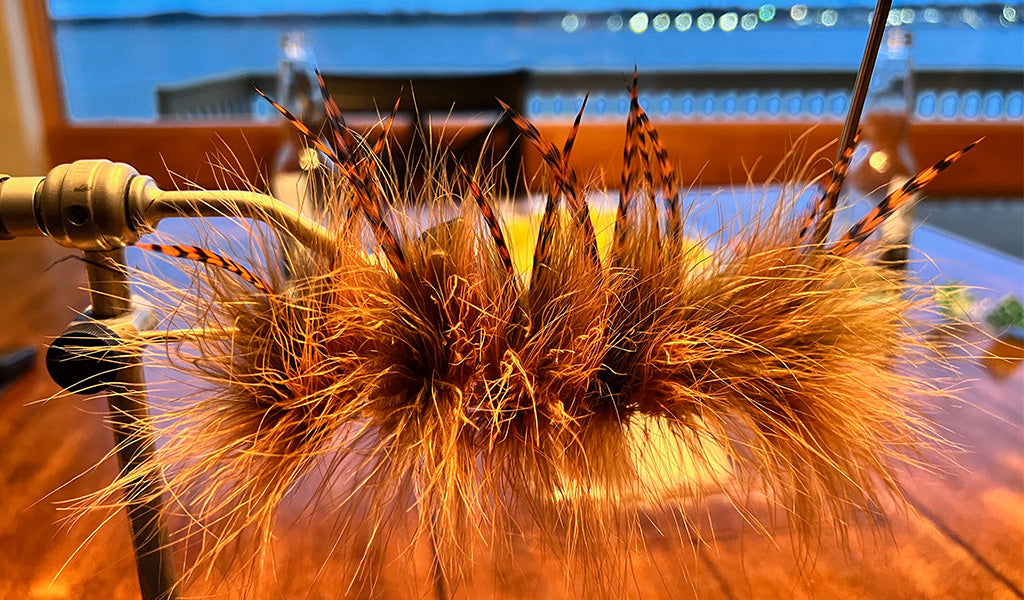
Effectively fishing with marabou jigs does require a specialized setup. Long casts, precise presentations, and detection of light bites all need to be achieved. Long 7’ to 8’ spinning rods in lighter actions work the best. My favorite setup to use for the technique is the Thorne Brothers Stealth MLXF rod in the 8’ length. This rod is light and has the perfect power and action for this technique. I pair the Stealth rod with a 3000 to 4000 size spinning reel. The larger spool size increases your casting distance and manages the light braid better. My preferred reel is the Diawa ballistic MQ LT for several reasons. This reel has a very smooth retrieve, silky drag, is light weight for its size and has a slower gear ratio. The slower gear ratio helps me slow down and find the perfect retrieve speed. Use 5-pound to 10-pound test braid for your main line and 6-pound to 10-pound test fluorocarbon for your leader. Leader test and length can be left to personal preference.
Personal preference is strongly associated with the presentation. There is no wrong way to fish with marabou jigs however, I will say there are some days when there’s a more right way to do it. Fishing them in the middle of the water column with some bottom contact or fishing the jig entirely on the bottom will all catch fish. By and large, a slow steady retrieve, mid water column will get the job done most days.
Another popular retrieve is to pendulum the lure through the water column. The best way I can describe this is when the lure lands in the water at the end of your cast, reel the slack out of your line. You want to feel the jig falling. Keep your rod tip pointed towards the jig at roughly 9 o’clock. When you feel the bottom, gently lift your rod tip to roughly 11 o’clock. When you feel the jig hit the bottom again, repeat, lifting your rod to 11 o’clock. Continue this retrieve pattern almost all the way to the boat. Once you get close to the boat or if your bait is too high in the water column, drop your rod tip near the surface and finish the cast with a steady retrieve.
The most important and hardest part of learning to fish marabou jigs is learning to feel where the lure is in the water column. The next is catching a fish and being able to repeat what triggered the bite on the next cast. Bass also love to eat these things on their initial decent to the bottom and right at the boat. Bites can vary from a distinct peck, getting slightly slacked up, or feeling slightly more weight than the drag of the jig. Using a high visibility main line helps to see bites that may go unnoticed.
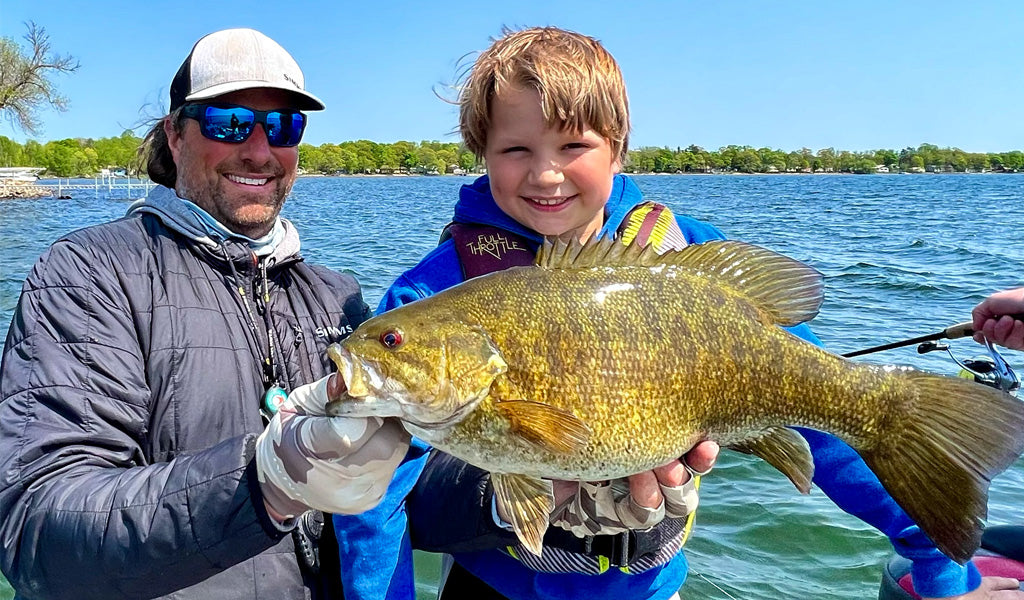
Another important detail of fishing with marabou jigs where personal preference is a factor is jig weight. Marabou jigs are effective in less than 1’ of water to as deep as you have the patience to fish them. Wind, current, and fish activity are all variables that should be accounted for when choosing the jig weight for the depth you are fishing. My favorite jig weight most of the time is 1/16oz. I feel pretty good about how this jig preforms to about 8’ in calm conditions. When I like to go up in weight to the 3/32oz is when it gets windy or when the bass are aggressive and want a faster retrieve. This is also the jig I reach for when fishing the 8’ to 15’ zones. The 1/8 oz size works well in heavy current and big waves. I also do enjoy experimenting with fall rates in shallow water with this size. I have seen the quick fall of a 1/8 oz. jig trigger neutral fish in shallow water.
Adding a piece of plastic to your jig is one of the last details of the technique. Tying on a keeper for adding a chuck of plastic is the first step when I spin up one of my jigs. Keepers are also found on many of the other high-quality marabou jigs you can purchase. Salt, scent, added profile, buoyancy and increased casting distance are benefits of adding a chunk of Senko or Berkley max scent to your jig. Palmered marabou jigs keep their profile while in the water because the marabou quills naturally stand straight out. I like to start fishing without a piece of plastic and make adjustments if needed. Similar to flies and other hand tied lures, two marabou jigs that look the same may not fish the same. One may catch fish right out of the box and another may need a piece of plastic to be productive. Certain jigs work so well right out of the box they get saved for special occasions. Experimenting with profiles and fall rates will make your experience more productive.
I can’t remember a single lure or style of fishing that has the same lore and regard as finesse marabou jigs. As a decade past, these jigs went from secret to overt. Typically, when a lure gains this kind of popularity, its productivity declines. Finesse marabou jigs have not taken that path. Finesse marabou jigs are now being used in a variety of lakes, reservoirs, rivers and streams throughout the country. A specialized jig that shined for pre-spawn smallmouth are now being used all season for all types of bass and other gamefish. Besides the jig's effectiveness, I believe there are other reasons for the intrigue. One is catching giant bass with light tackle. The other reason is the ease in which someone can craft their own jig. Not many experiences in freshwater fishing are as captivating as catching a trophy smallmouth with gear fit for panfish or small trout. It’s an even sweeter experience catching one on a lure you made. Quality content on the history of finesse marabou jigs, jig tying, and how to catch fish with them is readily available. Give it a search and then dive in. This patten is still my favorite way to catch smallmouth.
Finesse marabou jigs have been deadly for catching smallmouth bass for as long as I have been alive. For that same amount of time, the biggest problem with marabou jigs was finding one to buy. For the longest time, these jigs were heavily guarded by the anglers who used them and crafted them. You had to “know a guy” to get even a few of these jigs for yourself.
Roughly 10 years ago, I was talked into fishing a couple bass tournaments run out of Sturgeon Bay, Wisconsin. I was familiar with Sturgeon Bay, but until these tournaments, the lion's share of my efforts in that system were focused on muskies, not smallmouth.

The Door County area is legendary for its giant brown bass and unique fishing styles. Winning on Sturgeon Bay not only requires a lot of weight, it also means you are going to have to outfish the best bass anglers in the world.
Remember, by trade, I'm a muskie guide — making an attempt to be competitive at these tournaments is a huge challenge. Finesse bass fishing in ultra-clear water is the complete opposite of how I regularly earn my paycheck. Fortunately, information about bass fishing in the area was available. In addition, there was a community of generous anglers that were willing to share quality information with me. While researching and having countless conversations — two topics always came up: finesse marabou jigs and the Canadian bass anglers that implement the tactic. I identified two problems: — I didn’t know any Canadian bass anglers, and finding a high-quality marabou bass jig to purchase was next to impossible.
For over 20 years, I have been an employee, and Thorne Brothers pro staffer. Thorne Brothers is a large tackle shop and an incredible resource for just about every genre of fishing inclusive of fly fishing.
I have a good friend who manufactures muskie lures near my home who also makes bass jigs and spinnerbaits. He helped produce my first jig heads. With the help of these resources and some internet research, I began producing my own finesse marabou jigs. I never thought fishing these events would lead me to having a hobby business of crafting and selling marabou jigs during my off season. After talking to a few anglers and accumulating a pile of internet research, I was able to get a general idea of where to start.
In essences, finesse marabou jigs are flies tied on jigs with small hooks. Very light 1/16 oz, 3/32oz and 1/8oz are the appropriate jig head weights molded on a size 1 or 1/0 hook. The overall tied size when finished is “small”. Roughly 2” to 3” in length. The objective of the jig is to hang just off the bottom as you swim it or swing it along at slow speeds. When properly tied, these jigs have an incredible amount of movement when they are barely traveling through the water.

I observed a fly tying technique called palmering during an open fly tying event at Thorne Brothers. Palmering is a technique where the tyer wraps the stem of a feather around the shank of a hook. The benefit of this technique is that the quills of the feather stand straight out when wrapped. With the quills standing straight out, the jig has more action and drops slower. Both attributes are beneficial to the technique. Using this tying style uses the whole length of the quill. The average length of a quill is around 2” — a perfect length for an appropriately sized jig. Another feather that I incorporated is barred grizzly hackle. These feathers add action, contrast and a realistic profile. The feathers themselves can be mistaken for crayfish claws or appendages on a bug, both of which trigger big bass to eat. Palmering the marabou and adding the two hackle feathers makes my jigs unique while fitting the criteria of a finesse marabou jig.
Step 1: Start by tying on a wire keeper for adding a piece of soft plastic. This is also the point where I would add a few strands of flashabou (optional).

Step 2: The first feathers I add are two grizzly hackles splayed out, one on each side, cup side out. The grizzly hackles are trimmed to roughly 3”.

Step 3: Next, I palmer on two to four marabou feathers. There is a density that I’m looking for, not too sparse, but also, not too thick. Sometimes the desired density is achieved with two feathers and sometimes it takes four. Really, it’s dependent on the quality of feather. Ideally, the feathers you want to use are those with thinner stems and a uniform shape. You want the quills to be thinner and whisker like. Try to avoid using the bushy looking quills. If you are in a situation where the majority of the feathers you have are soft and bushy, use those as your base layer. The quills in the base layer are the least important. I also will pull the longer quills off the stem at the bottom of the feather. These are generally the poorest quality. Quality feathers truly increase the effectiveness of the jigs. You have to be willing to throw away subpar feathers even if it feels wasteful. It’s also fun to play with different quill densities used on each jig. There are times when a thinner profile will out fish a bulkier profile.

Step 3: One thing to keep in mind is how you finish the jig. For example, I try to keep the thread collar as small as possible. The marabou is where all the movement comes from. Therefore, the closer that movement starts to the jig head, the better.

There’s definitely a lot of personal preference when choosing the jigs heads you tie on. A few production heads work well if you are planning on only making a few jigs. However, If you are planning on getting serious, you may want to look into molding your own. There are jig molds made in several styles that make 1/16th, 3/32nd and 1/8th ounce jig heads. Each jig head style will perform slightly different. Fall rates, the way the bait pendulums through the water and how it lays on the bottom are all determined by the shape of the head. I sell 2 different styles of jigs. One model is made from Do-it’s Midwest finesse mold. This is a very flat mushroom style head. The flat design of this head makes it fall much slower than other jigs of the same weight. This type of jig is also easy to feel because of the water displacement it creates. Being able to have a sense of where your jig is at in the water column is one of the most challenging parts of fishing finesse hair jigs. To me, this is the best jig head style to learn the technique with. Another benefit to this head is that it stands upright which is important if you are going to incorporate bottom contact into your retrieve.
The second jig head that I sell is made with the Do-it Freestyle mold. This is a flat sided round head. It has a faster fall rate which means it can be fished at a faster pace. The flat sides also allows water to flow right past the head onto the marabou which gives the quills even more movement. I like this style when fishing deeper water.
Color is one of my favorite aspects of tying my own jigs. The general consensus is that all black is the best color you can use. Don’t get me wrong, it is a great color, however it’s not as effective in areas where marabou jigs are popular. It excels on overcast days or on waters that see little to no marabou jig fishing pressure. Personally, one of my favorite color schemes is the combination of ginger marabou and olive marabou. This color combination does a nice job of mimicking bugs and juvenile crayfish and seems to work everywhere whether it’s overcast or sunny. A little bit of fluorescent orange in a perch pattern or brown and orange crayfish pattern works really well in our big Minnesota lakes. All white is another solid color choice.

Effectively fishing with marabou jigs does require a specialized setup. Long casts, precise presentations, and detection of light bites all need to be achieved. Long 7’ to 8’ spinning rods in lighter actions work the best. My favorite setup to use for the technique is the Thorne Brothers Stealth MLXF rod in the 8’ length. This rod is light and has the perfect power and action for this technique. I pair the Stealth rod with a 3000 to 4000 size spinning reel. The larger spool size increases your casting distance and manages the light braid better. My preferred reel is the Diawa ballistic MQ LT for several reasons. This reel has a very smooth retrieve, silky drag, is light weight for its size and has a slower gear ratio. The slower gear ratio helps me slow down and find the perfect retrieve speed. Use 5-pound to 10-pound test braid for your main line and 6-pound to 10-pound test fluorocarbon for your leader. Leader test and length can be left to personal preference.
Personal preference is strongly associated with the presentation. There is no wrong way to fish with marabou jigs however, I will say there are some days when there’s a more right way to do it. Fishing them in the middle of the water column with some bottom contact or fishing the jig entirely on the bottom will all catch fish. By and large, a slow steady retrieve, mid water column will get the job done most days.
Another popular retrieve is to pendulum the lure through the water column. The best way I can describe this is when the lure lands in the water at the end of your cast, reel the slack out of your line. You want to feel the jig falling. Keep your rod tip pointed towards the jig at roughly 9 o’clock. When you feel the bottom, gently lift your rod tip to roughly 11 o’clock. When you feel the jig hit the bottom again, repeat, lifting your rod to 11 o’clock. Continue this retrieve pattern almost all the way to the boat. Once you get close to the boat or if your bait is too high in the water column, drop your rod tip near the surface and finish the cast with a steady retrieve.
The most important and hardest part of learning to fish marabou jigs is learning to feel where the lure is in the water column. The next is catching a fish and being able to repeat what triggered the bite on the next cast. Bass also love to eat these things on their initial decent to the bottom and right at the boat. Bites can vary from a distinct peck, getting slightly slacked up, or feeling slightly more weight than the drag of the jig. Using a high visibility main line helps to see bites that may go unnoticed.

Another important detail of fishing with marabou jigs where personal preference is a factor is jig weight. Marabou jigs are effective in less than 1’ of water to as deep as you have the patience to fish them. Wind, current, and fish activity are all variables that should be accounted for when choosing the jig weight for the depth you are fishing. My favorite jig weight most of the time is 1/16oz. I feel pretty good about how this jig preforms to about 8’ in calm conditions. When I like to go up in weight to the 3/32oz is when it gets windy or when the bass are aggressive and want a faster retrieve. This is also the jig I reach for when fishing the 8’ to 15’ zones. The 1/8 oz size works well in heavy current and big waves. I also do enjoy experimenting with fall rates in shallow water with this size. I have seen the quick fall of a 1/8 oz. jig trigger neutral fish in shallow water.
Adding a piece of plastic to your jig is one of the last details of the technique. Tying on a keeper for adding a chuck of plastic is the first step when I spin up one of my jigs. Keepers are also found on many of the other high-quality marabou jigs you can purchase. Salt, scent, added profile, buoyancy and increased casting distance are benefits of adding a chunk of Senko or Berkley max scent to your jig. Palmered marabou jigs keep their profile while in the water because the marabou quills naturally stand straight out. I like to start fishing without a piece of plastic and make adjustments if needed. Similar to flies and other hand tied lures, two marabou jigs that look the same may not fish the same. One may catch fish right out of the box and another may need a piece of plastic to be productive. Certain jigs work so well right out of the box they get saved for special occasions. Experimenting with profiles and fall rates will make your experience more productive.
I can’t remember a single lure or style of fishing that has the same lore and regard as finesse marabou jigs. As a decade past, these jigs went from secret to overt. Typically, when a lure gains this kind of popularity, its productivity declines. Finesse marabou jigs have not taken that path. Finesse marabou jigs are now being used in a variety of lakes, reservoirs, rivers and streams throughout the country. A specialized jig that shined for pre-spawn smallmouth are now being used all season for all types of bass and other gamefish. Besides the jig's effectiveness, I believe there are other reasons for the intrigue. One is catching giant bass with light tackle. The other reason is the ease in which someone can craft their own jig. Not many experiences in freshwater fishing are as captivating as catching a trophy smallmouth with gear fit for panfish or small trout. It’s an even sweeter experience catching one on a lure you made. Quality content on the history of finesse marabou jigs, jig tying, and how to catch fish with them is readily available. Give it a search and then dive in. This patten is still my favorite way to catch smallmouth.
This tournament performance mainstay now offers greater durability with increased denier face fabric, while maintaining a lightweight feel with a new modern, sleek look. Powered by leading edge GORE-TEX Pro fabric to offer unmatched durability and waterproof/breathable weather protection.
